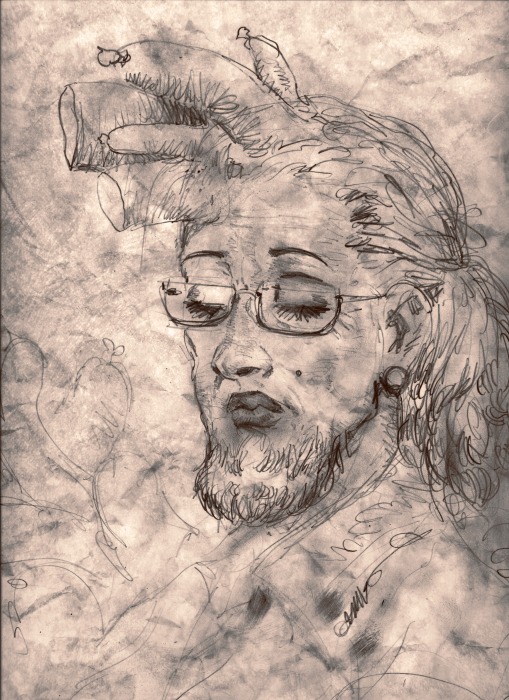A BRIEF HISTORY OF BEARDISM by Professor Frank Scopegate

Dictionary: Beardism, n. Pure pseudo-psychic automatism, by which one proposes to express, either verbally, in writing, or by any other manner, how history functions based on an (imagined) alternate past and the progression of industry. Dictation of thought in the absence of all control exercised by reason based on actuality (other than imagined actuality), outside of all aesthetic and moral preoccupation with the one proviso that the practitioner wear a beard.
Encyclopedia: Beardism. Philosophy. Beardism is based on the belief in the superior reality of certain forms of previously neglected alternate history, in the omnipotence of dream, in the disinterested play of thought married to the progression of industry (industriosophy). It tends to ruin once and for all other pseudo-psychic mechanisms and to substitute itself for them in solving all the principal problems of life whist wearing a beard.
William Morris (1834-1896) is often unreliably refered to as the "father of Beardism", marrying, as he did, socialism with poetry, fiction and design. In Europe, Alphonse Mucha (1860-1939) is often gifted with the title, though his art had very little to do with the philosophy that underlines Beardism. It is most likely simply the fact that he was bearded that led to this belief in certain circles, as Mucha never referenced it in any of his work, and, much like Morris before him, neither did he coin the term. Beardism as a cultural movement began in the early 1960s and is best known for the visual artworks and writings of its founding group members, Gerard Pointon (1921-1978), Richard Everret-Hyde (1939-1973) and Gladys Wilkinson (1905-2002). Notable amongst those who later joined the movement are the American artist, beat poet and writer of pseudo-hardboiled fiction Jon Pitore (1915-1989), Michael ‘Macky’ McKenzie (1927-1992) and the French-Italian artist and poet Sal LaRochelle (1931-1979).
The most celebrated Beardists works feature elements of surprise, unexpected juxtapositions and non sequiturs, and often references to the industrial British midlands, combined with the prerequisite facial furnishings. Many Beardist artists and writers primarily regard their work as an expression of the industrial/philosophical (industriosophical) movement, with the works being artifacts born out of an "imagined" alternate past. Pointon, of all of them, was most explicit in his assertion that Beardism was above all a counter-revolutionary movement, not just a form of expression, and this is reflected in the austerity of his artwork. Often compared to Dadaism, and later Surrealism, Beardism is distinct in the strict assertion that its practitioners wear, as was stated by Gladys Wilkinson, “the noble beard - that timeless muse-face of Pythagoras and Socrates - that gifts us Samsonite fortitude, and the wisdom of Moses” in her famous essay on Beardism "The Cloak That Masks Is No Cloak At All". Gladys remains the only beardist (and bearded) woman of the movement, and her strict belief in and adherence to the controversial beard rule was also the movement’s major stumbling block when it came under attack from feminists in the same decade it was birthed.
Formed in Stony Middleton, Derbyshire, from the 1960s on it spread around the globe, eventually being embraced by the visual arts, literature, film, and music, as well as political thought and practice, philosophy and social theory.
By the late 1970s and early 80s the original group had become fractured and many had moved on to other areas in media and art. "Macky" McKenzie was becoming influential as a conceptual artist, others had passed away, and the movement was sliding into obscurity. In 1976 Gerard Pointon was interviewed in the short-lived New York based art magazine "Avalanche" where he said "I'm not at all sure we've remained true to what we set out to do. It seems anybody with a beard can create just whatever they want and call themselves a Beardist. When we set out there was a mission... to change things, open eyes, alter reality, you know? Perceptions. Gladys (Wilkinson) at least kept the faith, but most of the others are pompous, fancy bloody posers out to make a name for themselves..."
In recent years a group of mostly UK midland based creators have revived the movement, putting on exhibitions and creating new works of art, prose, music and film. Notable amongst them are painter Chris Tree, artist/writer/publisher Liam Sharp, conceptual Beardist Alastair Pow3rs, tattooist and painter Adam Dutton, and sculptor Roger Sharp.
Beardist Gladys Wilkinson's study for "My Wurst Nightmare" or "Self-Portrait with German Sausage Head". Circa 1962.

